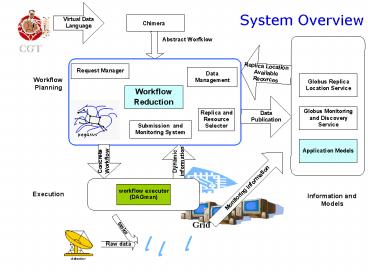Chimera and Pegasus - PowerPoint PPT Presentation
1 / 8
Title:
Chimera and Pegasus
Description:
Explores galaxy evolution inside the context of large-scale structure. ... Data intensive computations involving hundreds of galaxies in a cluster ... – PowerPoint PPT presentation
Number of Views:59
Avg rating:3.0/5.0
Title: Chimera and Pegasus
1
System Overview
2
Astronomy
- Galaxy Morphology (National Virtual Observatory)
- Investigates the dynamical state of galaxy
clusters - Explores galaxy evolution inside the context of
large-scale structure. - Uses galaxy morphologies as a probe of the star
formation and stellar distribution history of the
galaxies inside the clusters. - Data intensive computations involving hundreds of
galaxies in a cluster
The x-ray emission is shown in blue, and the
optical mission is in red. The colored dots are
located at the positions of the galaxies within
the cluster the dot color represents the value
of the asymmetry index. Blue dots represent the
most asymmetric galaxies and are scattered
throughout the image, while orange are the most
symmetric, indicative of elliptical galaxies,
are concentrated more toward the center.
People involved Gurmeet Singh, Mei-Hui Su, many
others
3
Astronomy
- Sloan Digital Sky Survey (GriPhyN project)
- finding clusters of galaxies from the Sloan
Digital Sky Survey database of galaxies. - Lead by Jim Annis (Fermi), Mike Wilde (ANL)
- Montage (NASA and NVO) (Bruce Berriman, John
Good, Joe Jacob, Gurmeet Singh, Mei-Hui Su) - Deliver science-grade custom mosaics on demand
- Produce mosaics from a wide range of data sources
(possibly in different spectra) - User-specified parameters of projection,
coordinates, size, rotation and spatial sampling.
4
Montage Workflow
Transfer the template header
Transfer the image file
Re-projection of images.
Calculating the difference
Fit to a common plane
Background modeling
Background correction
Adding the images to get the final mosaic
Register the mosaic in RLS
5
BLAST set of sequence comparison algorithms that
are used to search sequence databases for optimal
local alignments to a query
- 2 major runs were performed using Chimera and
Pegasus - 60 genomes (4,000 sequences each),
- In 24 hours processed Genomes selected from
DOE-sponsored sequencing projects - 67 CPU-days of processing time delivered
- 10,000 Grid jobs
- gt200,000 BLAST executions
- 50 GB of data generated
- 2) 450 genomes processed
- Speedup of 5-20 times were achieved because the
compute nodes we used efficiently by keeping the
submission of the jobs to the compute cluster
constant.
Lead by Veronika Nefedova (ANL) as part of the
Paci Data Quest Expedition program
6
Biology Applications (contd)
- Tomography (NIH-funded project)
- Derivation of 3D structure from a series of 2D
electron microscopic projection images, - Reconstruction and detailed structural analysis
- complex structures like synapses
- large structures like dendritic spines.
- Acquisition and generation of huge amounts of
data - Large amount of state-of-the-art image processing
required to segment structures from extraneous
background.
Dendrite structure to be rendered by Tomography
- Work performed by Mei Hui-Su with Mark Ellisman,
Steve Peltier, Abel Lin, Thomas Molina (SDSC)
7
Physics (GriPhyN Project)
- High-energy physics
- CMScollaboration with Rick Cavannaugh, UFL
- Processed simulated events
- Cluster of 25 dual-processor Pentium machines.
- Computation 7 days, 678 jobs with 250 events
each - Produced 200GB of simulated data.
- Atlas
- Gravitational-wave science (collaboration with
Bruce Allen A. Lazzarini and S. Koranda)
8
LIGOs pulsar search at SC 2002
- The pulsar search conducted at SC 2002
- Used LIGOs data collected during the first
scientific run of the instrument - Targeted a set of 1000 locations of known pulsar
as well as random locations in the sky - Results of the analysis were be published via
LDAS (LIGO Data Analysis System) to the LIGO
Scientific Collaboration - performed using LDAS and compute and storage
resources at Caltech, University of Southern
California, University of Wisconsin Milwaukee.
ISI people involved Gaurang Mehta, Sonal Patil,
Srividya Rao, Gurmeet Singh, Karan
Vahi Visualization by Marcus Thiebaux































